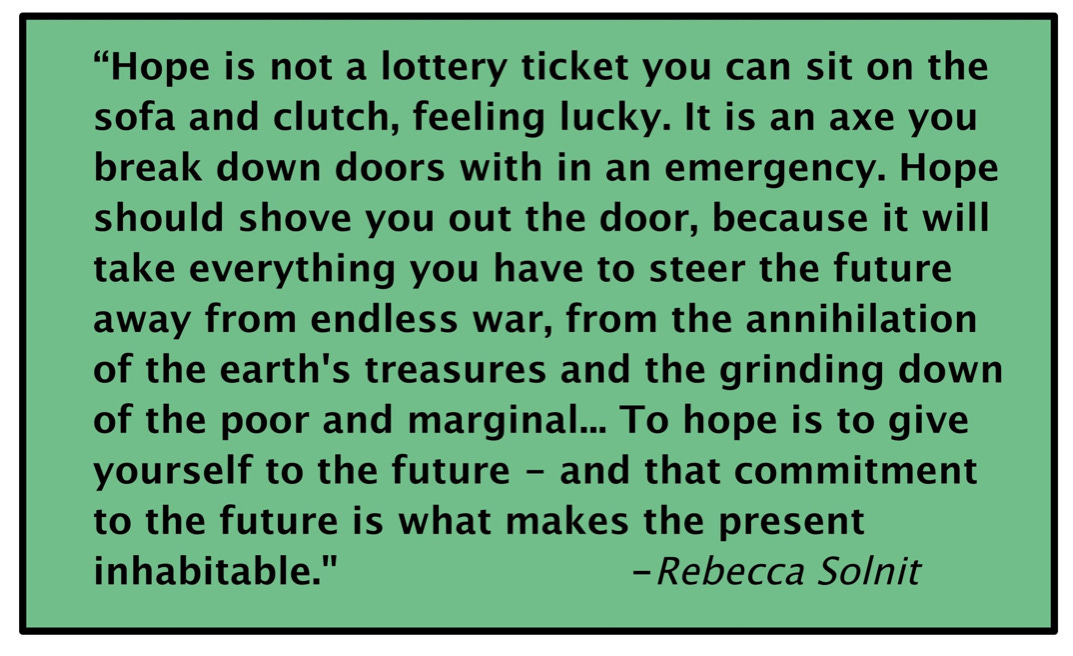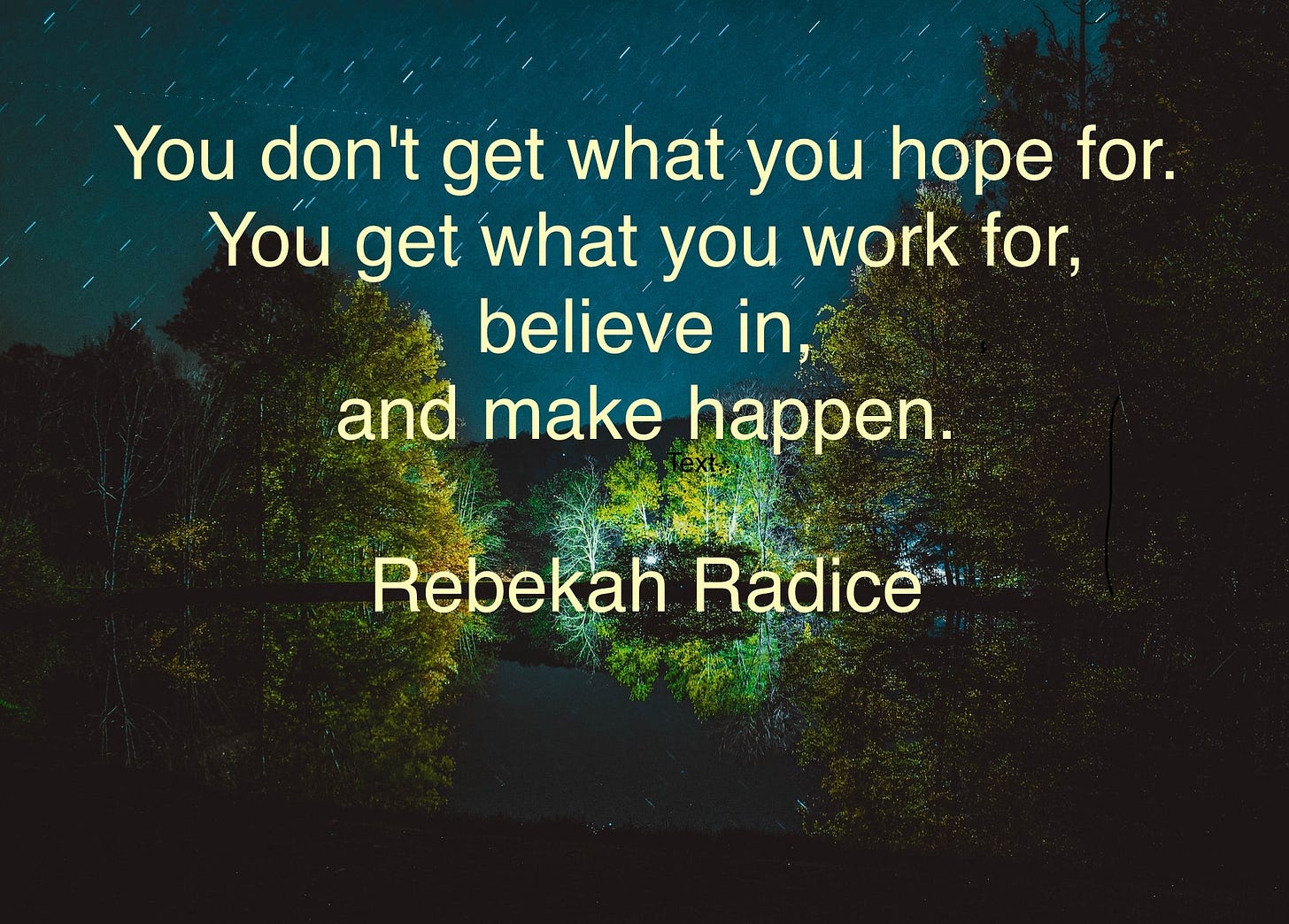Where does hope fit in?
Thoughts on hope in challenging times— from Emily Dickensen to Paul Hawken

You’re at Mother E, a free newsletter about our connections to nature and other species in a climate-changing world. If you missed the last edition, it’s here: The Fox Who Shared My Food
If this newsletter gets shortened by an email program or the images don’t show, you can read it on the website here. To get Mother E coming to your email box every other Sunday, sign up below.
Hope is the thing with feathers
That perches in the soul
And sings the tune without the words
And never stops, at all
Emily Dickinson, from her poem “Hope is the thing with feathers”
WHAT IS THE ROLE OF HOPE in challenging times?
I'm seeing more climate anxiety recently and a darker outlook. This is a normal reaction to the challenges seen this year: scorching fires and parching droughts in the West, damaging flooding in other places, and more loss of human life and wildlife. Our planet is reacting to the excesses of our species by passing tipping points into unstable zones.
The question of where hope fits in was posed on Twitter recently, and a lively discussion thread followed. Younger people are feeling less hopeful about what comes next. People of all ages are feeling unsettled and less secure about the future.
Looking in the rearview mirror, we've benefitted from an exceptionally stable climate since the last Ice Age, around 11,700 years ago. Earth's climate has even supported complex life forms as far back as 600 million years ago.
Life on Earth has a long history, but it's also been cut back five times by mass extinction events, and we appear to be in the sixth, this one likely caused by us. I saw an estimate that mammal species survive, on average, about one million years before they go extinct.
Shifts in climate – both large and small – are at least partly responsible for the rise and fall of many ancient civilizations.
https://climate.nasa.gov/news/1010/climate-change-and-the-rise-and-fall-of-civilizations/
A stable climate and civilization go hand in hand. The opposite may also be true and I wonder if some of the social upheaval in the world today stems from climate stressors we’ve caused.
This decade is a period when we need hope, but it's hope with a caveat. I’ll pull thoughts from the collective wisdom of four author-thinkers to explore this more.
Rebecca Solnit—Hope is not a lottery ticket.
Rebecca Solnit is a contemporary voice for social and ecological justice, and she's also a clear-eyed realist about what problems we face and what needs to change. For her, "to hope is to give yourself to the future." That makes the present livable and even turns it into a hero's journey of sorts.
Rebecca Solnit's hope stems from a fierce love of people and place. When you love something, you want it to live on and thrive. Her style of hope will "break down doors" to keep life going. There's power in that commitment.
Paul Hawken—You can't have hope without fear
In his role as a climate activist and one of the co-founders of Project Drawdown, Paul Hawken says he often gets asked if he has hope.
Well, I am not a big fan of hope. Hope is the mask of fear. They are two sides of the same thing. You can't have hope without fear. We need to be fierce and fearless, not hopeful.
….
We know that fear and threat light up the amygdala, the fight, flight or freeze response of the brain, a response that shuts down the prefrontal cortex, which is the problem-solving part of the brain. Problems need to be presented in the context of solutions that people see a benefit in.
Paul Hawken, entrepreneur, author of Regeneration, and cofounder of Project Drawdown
Climate language often uses battle metaphors: fight, combat, slashing emissions, decarbonization. Hawken says what we need is to collaborate more rather than make war on CO2 or other perceived enemies.
The language and mindset of healing the Earth and atmosphere needs to employ these words: restore, renew, rejuvenate, regeneration, connect, purpose, meaning, respect.
Paul Hawken, entrepreneur, author of Regeneration, and cofounder of Project Drawdown
Hawken's cofounder of Project Drawdown is Amanda Ravenhill, who said, "Carbon is the element that holds hands and collaborates." For Hawken, hope comes from reaching out to others, including nature, to co-create solutions that benefit all.
Richard Powers— Storytelling the power of grief and hope
Richard Powers, Pulitzer Prize-winning author of The Overstory, Bewilderment, and other novels explores the connection between hope, grief, love, and commitment.
In The Overstory book, he reimagines the role of hope fused with a love of trees and places as a catalyst for change. He uses the power of grief to slingshot his characters into action. Like Rebecca Solnit, he shows the deep connection between hope and care for the future.
Hope means a commitment to engage the future as a meaningful pursuit. I do hope, and I strongly believe that this place where we are [Earth] that is still so incredible will provide us with a meaningful place to put all our efforts and all our empathy for as long as we can stick around.
Richard Powers, author in an interview
Robin Wall Kimmerer— Hope arises from an honorable relationship with nature.
Robin Wall Kimmerer is one of my favorite authors, as she explains the respectful indigenous way of relating to nature, seeing the mystery and glow at the heart of all life. She's also an award-winning scientist with a poet's mindset, and she bridges those worlds to merge seemingly opposite fields into a unified whole.
We need acts of restoration, not only for polluted waters and degraded lands, but also for our relationship to the world. We need to restore honor to the way we live, so that when we walk through the world we don't have to avert our eyes with shame, so that we can hold our heads up high and receive the respectful acknowledgment of the rest of the Earth's beings.
Robin Wall Kimmerer, scientist, author of Braiding Sweetgrass, decorated professor, and enrolled member of the Citizen Potawatomi Nation.
Perhaps hope resides along a spectrum. Wishful-thinking hope is at one end and active hope is at the other. Both may be needed at different times, integrating day-dreaming with concrete efforts.
Right now, the world needs more active hope, which is a muscled arm pulling a desired future closer. It asks us to think globally but act locally. It dares us to imagine— what does it look like if we succeed?
Active hope asks more from us than we think we can give, yet it also fills up our soul with purpose and the joy of discovering our power to affect the future. Active hope connects us to the long lineage of life’s striving on Earth.
Robin Applegarth
I like to hear from readers!
My musings on hope feel unfinished and insufficient, but these are the types of conversations we need to start having if our species wants to survive. Do you think we need hope to act?
You can comment at the button above, respond to this email to reach me privately, or reach out on Twitter @RobinApplegarth.
Thank you for reading Mother E and for your involvement in making the world a better place!
Not subscribed yet? Mother E is a free newsletter about our connections to other species in a climate-changing world. Sign up below to have it delivered to your email box every other Sunday.




Wonderful and inspiring. That took a lot of research and reading. Thx Robin. 👍
a well written look at the spectrum of possible responses to challenging times. thanks